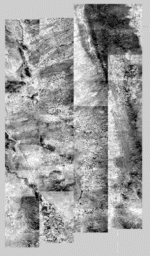Advancing Remote Sensing Technology at the Jornada LTER
Laura F. Huenneke, New Mexico State University, Department of Biology and Kris Havstad, USDA-Agricultural Research Service, Jornada LTER
Arid and semiarid lands cover nearly one third of the earth’s land mass and are of considerable importance from both human and ecological perspectives. Unfortunately, drylands are notoriously difficult to sample and monitor, given their vast extent, harsh environmental conditions, and sparse biota that varies tremendously over space and time. The development of efficient methods for monitoring aridlands and for extrapolating from small plot or process studies to useful spatial scales has become an important objective for remote sensing researchers.
The Jornada Basin LTER site has become an important laboratory for the development and testing of remote sensing technologies in arid landscapes. For more than a decade, researchers in Geography from New Mexico State University and from San Diego State University have worked to apply satellite sensing technology to the Jornada’s landscapes and to correlate these data with handheld reflectrometry. In recent years the pace, breadth, and intensity of work has picked up considerably. Here we describe several of the most recent efforts to advance remote sensing research at the Jornada.
The JORNEX project is funded by the USDA Agricultural Research Service (ARS) global change research program, and includes researchers from five ARS research units (including Al Rango and several others from the Hydrology Laboratory in Beltsville) and from the Staring Centre in Wageningen, The Netherlands. The goal is to quantify land surface hydrology and energy balance in the heterogeneous landscapes of the Jornada basin. The 1995-96 field campaigns integrated airborne remote sensing and ground measurements with the ongoing productivity measurements of the LTER program and satellite data from Landsat TM (thematic mapper), NOAA-AVHRR (Advanced Very High Resolution Radiometry), and GOES-VISSR. Fixed-wing aircraft provided several types of data (multispectral video imagery, laser altimetry, thermal infrared radiometer, 4-band visible and near-infrared radiometer) from several altitudes; while on-the-ground measurements were made of spectral reflectance, LAI (Leaf Area Index), surface energy flux (from Bowen ratio and eddy correlation measurements), and vegetative composition and structure. In 1997-98, the project was expanded to include cross-site work with the Sevilleta and Shortgrass Steppe LTER sites. Barbara Nolen, the GIS specialist for the Jornada LTER and the Jornada Experimental Range, provided extensive leadership and coordination of the multiple agency interaction. Her organizational efforts included acquiring approvals for flights over White Sands Missile Range and the Mexican border -- a tremendous logistical challenge!
A project led by Jornada / New Mexico State University investigator Vince Gutschick, funded by the U.S. Department of Energy’s National Institute for Global Environmental Change (NIGEC), focuses on regularities in plant control of evapotranspiration and carbon gain across sites. The project is an effort to move from measurements of water and carbon flux at the leaf and plant (physiological) scales to the regional (km) scale, testing the representativeness of data from flux-tower sites. Remote sensing methodology is primarily low-level aerial photography analyzed by image processing, giving LAI and vegetative composition and structure over intermediate scales. Investigators are now using Landsat TM imagery to estimate evapotranspiration using the energy residual method. The project ties together six sites nationally (five that have long-term flux monitoring).

 Enlarge this image
Enlarge this image